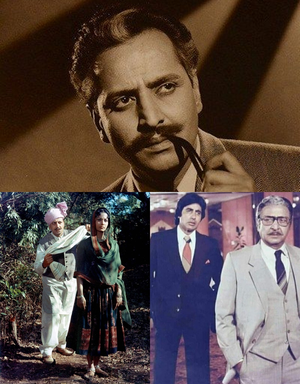New Delhi: Notorious for terrorising at least two generations of top heroes – in reel life – with just his trademark glare, steely voice, and facial expressions ranging from ferocious to sneering, he especially stood out for his film relations with Bollywood megastar Amitabh Bachchan, whom he once bested onscreen with two words.
In one standard of the lost-and-found potboiler genre, Amitabh, with his role’s habitual insouciance, asks a stern-looking, impeccably-dressed character: “Aap kaun hai mai-baap?”. Pat came the terse reply: “Tumhara baap”.
This was “Amar Akbar Anthony” (1977) – one of the 11 that Pran, born on this day (February 12) in 1920 – did with the Big B, playing with his father two times more or a reluctant ally. Of these, at least 9 are intrinsic to the Bachchan legend, including “Zanjeer” (1973), “Don” (1978), “Naseeb” (1981), “Kaalia” (1981), “Sharaabi” (1984), and “Shahenshah” (1988)
Pran also had a major part in launching the Big B’s path to stardom as it was he – and co-star Ajit – who convinced Prakash Mehra to cast Amitabh, then a relative nobody despite 15-odd films, as hero in “Zanjeer”.
One of the few actors who entered the industry without wanting to become a hero, his contribution to the Indian film industry was unmatched. When Pran passed away in 2013, the centenary year of Indian cinema, he had been acting for nearly two-thirds of his 93 years, mostly as such a convincing villain that Indian parents did not use his name for their children for at least a quarter of a century!
Among the highest-paid actors in his time – sometimes even more than the hero, and a character actor with over a dozen songs, he also had the unique privilege of his name coming by itself at the end of the casting as: “And Pran”.
As he transformed the Hindi film villain from a stereotype to a well-delineated character, his reward was people abusing him in public, children hiding from him, most female stars afraid of him and his name becoming taboo for two generations.
Son of a prosperous government civil contractor Kewal Krishan Sikand, Pran did not seem destined to be an actor – apart from an appearance as Sita in a Ram Leela in Simla – with Madan Puri playing Ram!
He entered films in purely filmi style – after a chance encounter at a pan shop in Lahore where he was working with a leading photograph studio.
Impressed by the way Pran ate a pan, a man approached him and asked him to come to a famous producer’s office the next day to test for a role. Pran thought it a joke and forgot all about it. But when went to the cinema the next Saturday, he ran into the same person – film writer Wali Mohammad, who walked across and “began abusing me with choice Punjabi invectives” and came to his house to pick him up, he recounted later.
He debuted as villain in ‘Yamla Jat’ (Punjabi, 1940) and then was cast as hero in the studio’s first Hindi film ‘Khandan” (1942) – opposite Noor Jehan. He did two dozen-odd films till Partition – mostly as a hero, though he later confessed that he did not like singing songs and chasing heroines around trees!
After Partition, his family moved to Bombay, but he failed to find any work, facing rejection after rejection, despite intervention by friends like actor Shyam and writer Sadat Hasan ‘Manto’.
His fate turned with Bombay Talkies casting him as villain in “Ziddi” (1949) – which also launched Dev Anand’s career as a hero. Offers started pouring in and his career was on a roll again – and continued till he retired in the 1990s due to his age and health issues.
Among his trademark roles were as the eponymous character in costumed drama ‘Halaku’ (1956), playing Genghis Khan’s grandson with panache – opposite Ajit and Meena Kumari, Dilip Kumar’s tormentor in films like “Madhumati” (1958), “Dil Diya Dard Liya” (1966), and “Ram Aur Shyam” (1967), Raj Kapoor’s near nemesis in “Jis Desh Mein Ganga Behti Hain” (1959) — where his rubbing of neck was to portray the dacoit’s fear of the noose, Shammi Kapoor’s thorn in “Kashmir ki Kali” (1964) and “Brahmachari” (1968) and of Dev Anand in “Munimjee’ (1955)
However, roles of the dacoit in Manoj Kumar’s “Shaheed” (1965) and Malang Chacha in “Upkar” (1967) paved way for more positive characters – though he had played the loyal doctor friend in Raj Kapoor’s “Aah” (1953) and this was attributed as a factor for it flopping!
Pran was also noted for turning down a Filmfare Award to protest a deserving candidate being left out in another category, initiated a fund to support distressed film artistes and technicians, and was one of the rare Bollywood figures who publicly criticised the Emergency.
(Vikas Datta can be contacted at vikas.d@ians.in)
–IANS


Comments are closed.